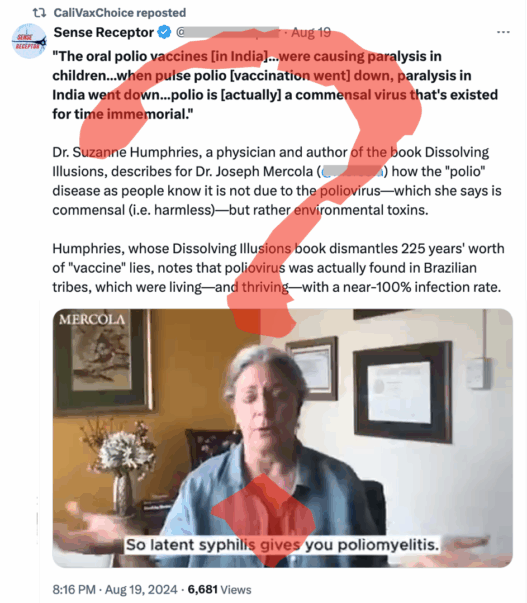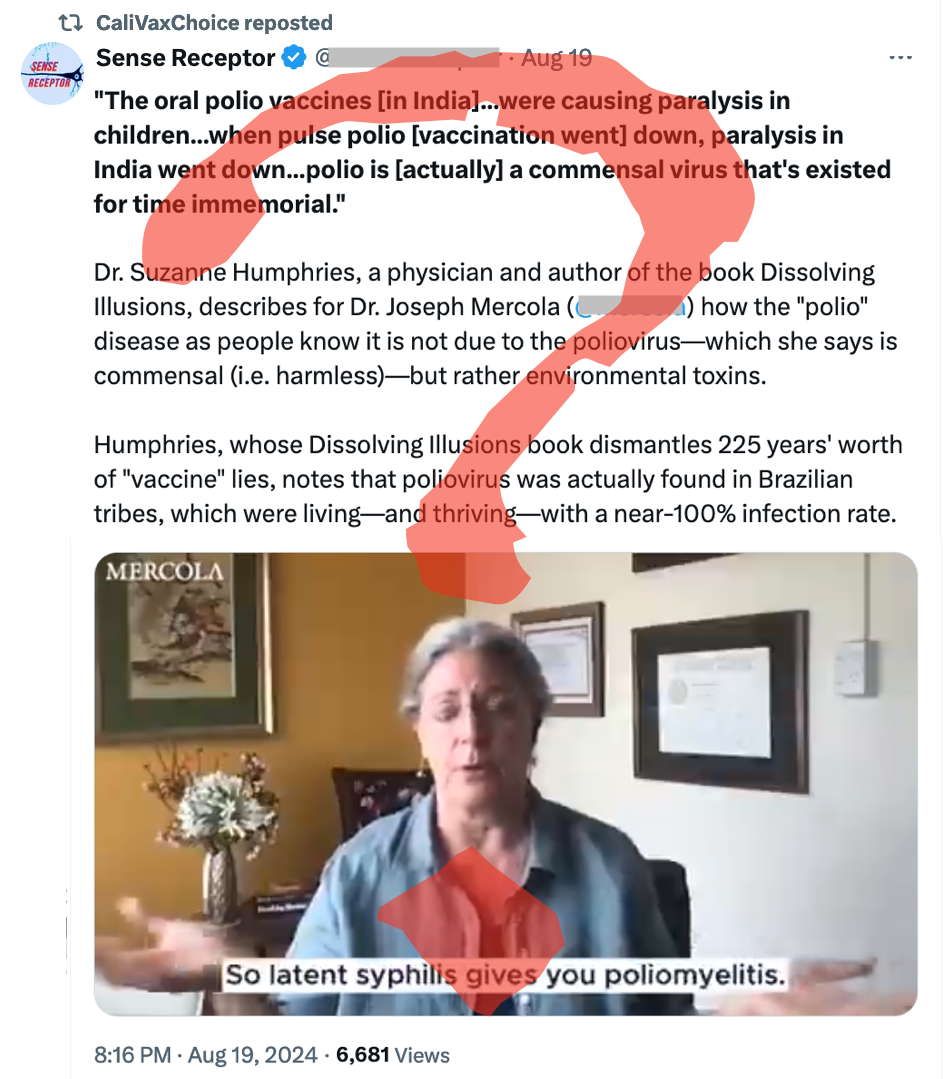Suzanne Humphries is one of those anti-vaccine influencers who likes to go back into the pre-vaccine era to try to prove that vaccines don’t work and aren’t necessary.

And that she does it with such confidence is kind of scary…
Polio and the Xavante Indians of Brazil
Why is it scary?
Because she is almost always wrong!
For one thing, polio is not a commensal virus!
“…a relation between two kinds of organisms in which one obtains food or other benefits from the other without damaging or benefiting it”
Merriam-Webstar definition of commensalism
Polio can certainly harm us!
So why didn’t the Xavante Indians of Brazil develop paralysis even though they had evidence of previous polio infections?
The same reason most other people didn’t develop paralysis until relatively modern times. They likely were exposed to polio and got sick at a very young age, as infants, and then had life-long immunity.
This is unlike those who weren’t exposed until they were a little older, when polio is more likely to cause paralysis.
Now why would your exposure be delayed?
You can thank improved hygiene, sanitation, and better living conditions.
But how did they end up getting polio in the first place?
“There are only a few scattered references to the Xavante in the literature on Central Brazil. We know they fought the settlers in the eighteenth century and that they probably moved westward to their present habitat about the middle of the nineteenth century. Since then they have reacted violently to anything which they considered encroachment on their territory, so that until the 1940’s their contacts with western culture were largely hostile.”
Studies on the Xavante Indians of the Brazilian Mato Grosso
The Xavante obviously had plenty of contact with other people!
They were not an uncontacted tribe that had been isolated in the rain forest, away from all other people.
And of course, polio is fairly contagious.
What Else Suzanne Humphries Gets Wrong About Polio and the Xavante Indians
In her book, Dissolving Illusions, Suzanne Humphries pushes the idea that polio epidemics were caused by DDT and/or arsenic poisoning…
So you won’t be surprised that she gets everything wrong about polio and the Xavante Indians, will you?
“The following account records a pilot study of a Xavante Indian village near the Rio das Mortes in the State of Mato Grosso, Brazil.”
Studies on the Xavante Indians of the Brazilian Mato Grosso
For one thing, the studies she seems to be using by J.V. Neel from the 1960s leave out some important details.
“In 1958, the population of the village under study had fluctuated between 200 and 220. The size of the village on this visit was approximately 110. This striking reduction was due primarily to the earlier mentioned village schism occurring shortly after the studies of 1958.”
Studies on the Xavante Indians of the Brazilian Mato Grosso
Next, you should know that a lot of the children of the Xavante Indians were dying!
“Ranke (1898) records that 86 married women from six villages had borne 360 children of whom only 141 (39 per cent) were alive at the time of his visit. On the face of it, this is a higher mortality than we encountered, but because of the large proportion of women over 40 whom he appears to have questioned, it is possible that these figures include young adults lost in accidents and battle. Taken at face value, our data indicate a population at present replacing itself, but there are ominous signs that this situation may not persist.”
Studies on the Xavante Indians of the Brazilian Mato Grosso
It was far from the garden of Eden type setting that Suzanne Humphries depicts with “people that were living close to the earth living healthy lives.”
“Finally, one child approximately 4 years old was encountered who could be a “problem child” in any culture-antagonistic, uncooperative, given to temper tantrums.”
Studies on the Xavante Indians of the Brazilian Mato Grosso
What else did the researchers find:
- that ‘with respect to the elders, too few were seen to permit generalizations.’
- ‘the relative absence of individuals over 40 years of age is one of the most troublesome observations to emerge from this study.’
- that ‘one female, aged 18, was alleged by the Xavantes to be subnormal mentally’
- two young male Xavantes stood out from the others as almost certainly mentally retarded.
- an adult with seizures
- one child with club foot
They found a lot of things that folks like Suzanne Humphries think don’t exist unless they are caused by vaccine injuries!
“From the standpoint of understanding the operation of natural selection at this cultural level, it is of some considerable importance to know whether deaths among adults are predominantly due to disease or to trauma and, if the latter, whether through hunting accidents or warfare, internicine as well as external. Information concerning all aspects of the latter is difficult to acquire, but Maybury-Lewis (1965, 1967) has provided some basis for inference concerning its importance. If, on the other hand, the paucity of oldsters is due to the effects of endemic disease, the loss of compensation which is implied represents a most interesting phenomenon.”
Further studies on the. VI. The physical status of the Xavantes of Simões Lopes
And Humphries is not the only one
Note: prior to 1900, polio was extremely rare, but then suddenly exploded in incidence, suggesting something made the virus more pathogenic (e.g., populations like the Xavante Indians of Brazil existed that had widespread poliovirus infections but no cases of polio).
The Forgotten History of Neurological Vaccine Injuries by A Midwestern Doctor
A Midwestern Doctor provides no evidence that anything made the polio virus more pathogenic though…
Ironically, in the case of polio, we simply saw one of the downsides of having better hygiene and sanitation.
More on the Xavante Indians of Brazil
Last Updated on May 12, 2025


